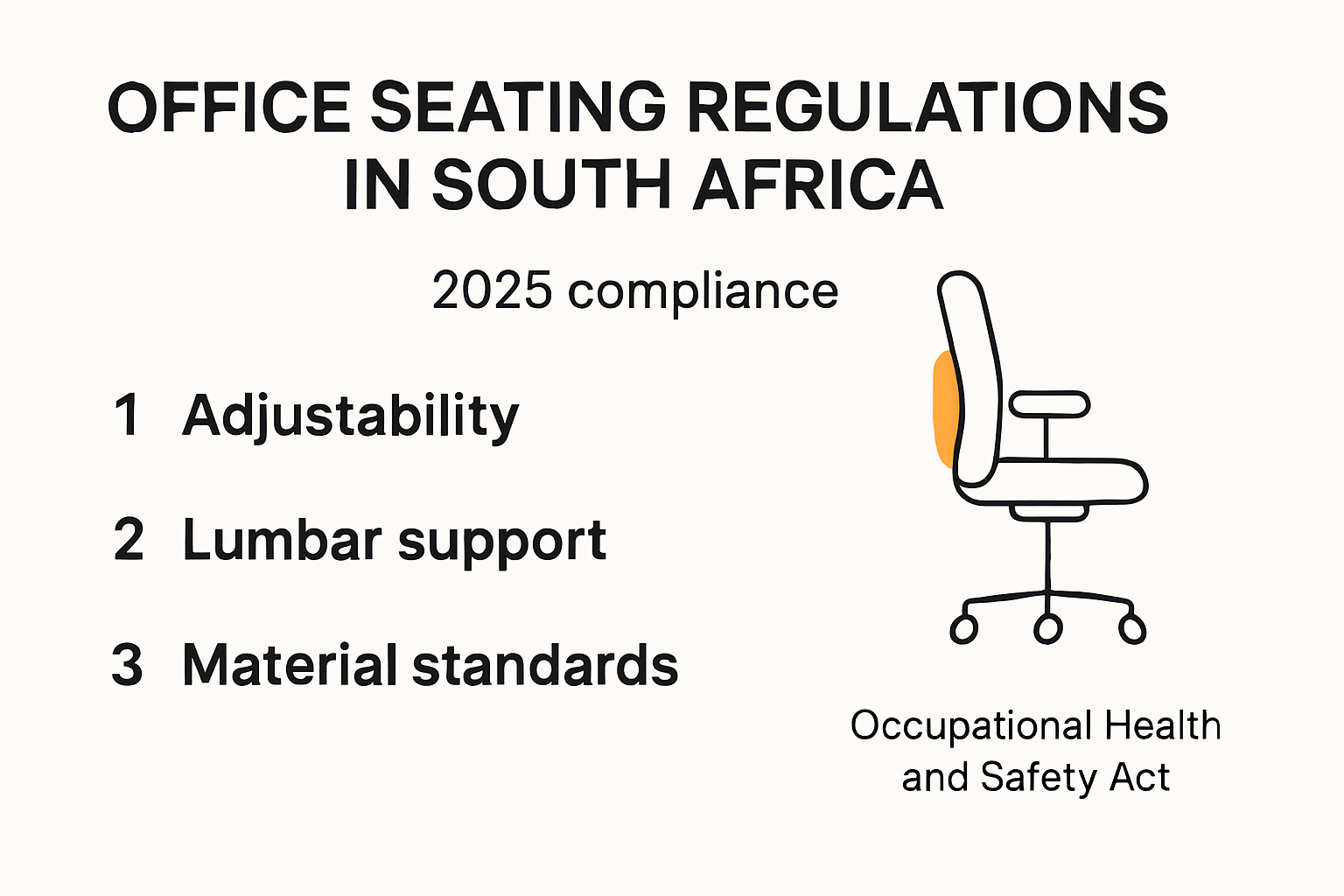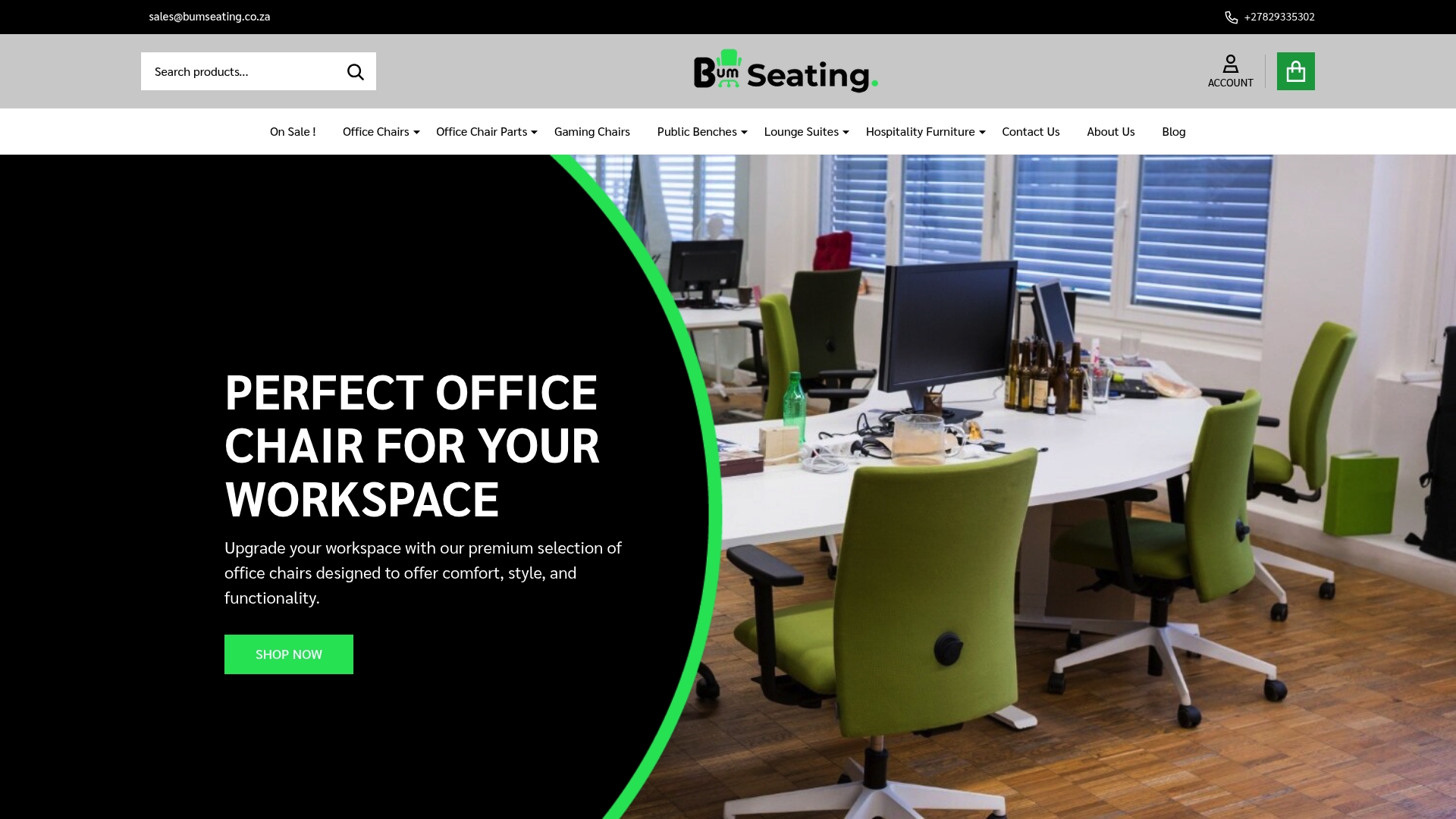Office Seating Regulations South Africa: 2025 Compliance Guide
19th Jul 2025
Office Seating Regulations South Africa: 2025 Compliance Guide

Office seating rules in South Africa are about to step up in a big way and every business will be affected. Most people reckon a comfortable chair just keeps you from getting tired but the new regulations for 2025 mean much more than that. Soon, all office chairs must have multiple adjustment points, proper lumbar support, breathable materials, and accommodate different body types or your business risks serious penalties. This changes the way companies think about health at work and it is not as simple as buying a few new chairs.
Table of Contents
- Understanding Office Seating Regulations In South Africa
- Key Compliance Requirements For 2025
- Choosing Seating That Meets Legal Standards
- Tips For Implementing Ergonomic Seating Solutions
Quick Summary
| Takeaway | Explanation |
|---|---|
| Understanding Legal Compliance | South African businesses must adhere to specific ergonomic standards under the Occupational Health and Safety Act, focusing on adjustable seating, proper lumbar support, and accommodating movement. |
| Conducting Ergonomic Assessments | Employers are required to perform detailed ergonomic assessments that evaluate physical workstations and individual employee needs to mitigate health risks. |
| Technical Specifications for Seating | Compliance requirements for 2025 stipulate that office chairs must have multiple adjustment points, proper lumbar support, breathable materials, and must accommodate diverse body types. |
| Documentation and Training Importance | Maintaining thorough documentation of ergonomic assessments and providing employee training on proper seating use are critical for compliance and employee health. |
| Ongoing Monitoring Necessity | Continuous evaluation and adaptation of seating solutions, as well as tracking employee comfort, are essential for maintaining a healthy workplace environment. |
Understanding Office Seating Regulations in South Africa
Office seating regulations in South Africa represent a critical framework designed to protect employee health and workplace ergonomics. Bum Seating recognizes the importance of these guidelines in creating safe and productive work environments across the nation.

Legal Framework for Workplace Ergonomics
The South African workplace ergonomics landscape is governed by comprehensive regulations that mandate specific requirements for office seating. Explore our ergonomic seating solutions that align with national workplace standards. According to the Department of Employment and Labour, the Ergonomics Regulations implemented in December 2019 represent a pivotal moment in workplace safety legislation. These regulations require employers to implement structured programs that control exposure to ergonomic hazards, with a specific focus on office seating arrangements.
The legislative approach stems from a recognition that improper seating can lead to significant health risks. Musculoskeletal disorders, chronic pain, and reduced productivity are direct consequences of non-compliant office seating. Employers are now legally obligated to assess and mitigate these risks through carefully selected and positioned seating solutions.
Key Compliance Requirements
Under the Occupational Health and Safety Act of 1993, South African businesses must adhere to specific ergonomic standards. As Minister Thulas Nxesi emphasized during the 2020 regulation launch, the primary goal is to eliminate workplace-related health risks. The regulations mandate that employers provide:
- Adjustable Seating: Chairs that can be customized to individual employee physiques
- Proper Lumbar Support: Seating that supports the natural curvature of the spine
- Movement Accommodation: Chairs that allow for dynamic sitting and posture changes
The Facilities Regulations of 2004 further stipulate that employees whose work can be effectively performed while sitting must be provided with appropriate seating. This extends to workers typically standing, who should have the option to sit when possible.
Bum Seating stands at the forefront of these regulatory requirements, offering comprehensive seating solutions that not only meet but exceed south-african workplace safety standards. Our product range is meticulously designed to address the nuanced ergonomic needs of modern workplaces, ensuring both legal compliance and employee well-being.
By understanding and implementing these regulations, businesses can create healthier, more productive work environments. The investment in proper office seating is not just a legal requirement but a strategic approach to employee health and organizational performance.
Call to Action: Ready to transform your workplace with compliant, ergonomic seating? Discover our range of office seating solutions that meet south-african workplace regulations and support employee wellness.
Key Compliance Requirements for 2025
As workplace dynamics continue to evolve, Bum Seating recognizes the critical importance of staying ahead of office seating regulations in South Africa for 2025. The upcoming compliance landscape demands a comprehensive approach to workplace ergonomics and employee well-being.
Ergonomic Assessment and Workplace Design
Employers must now implement rigorous ergonomic assessments that go beyond traditional seating evaluations. Explore our comprehensive seating solutions designed to meet the latest regulatory standards. According to the Occupational Health and Safety Act, businesses are required to conduct thorough workplace ergonomic evaluations that specifically address individual employee needs.
Key components of these assessments include:
- Detailed physical workstation analysis
- Individual employee physiological measurements
- Comprehensive risk assessment for potential musculoskeletal disorders
The Environmental Regulations for Workplaces mandate that seating solutions must be adaptable to individual employee requirements. This means employers cannot rely on one-size-fits-all approaches to office seating.

Technical Specifications and Compliance Criteria
For 2025, the compliance requirements have become significantly more stringent. The Facilities Regulations, 2004 now require more detailed technical specifications for office seating. Employers must ensure that chairs meet specific criteria:
- Adjustability: Chairs must offer multiple adjustment points including seat height, backrest angle, and armrest positioning
- Lumbar Support: Comprehensive lower back support that adapts to individual body shapes
- Material Specifications: Breathable materials that support long-term comfort and hygiene
- Load Capacity: Chairs must safely support diverse body types and weights
The regulations emphasize that seating is not merely about comfort but about preventing long-term health issues associated with prolonged sitting.
Here is a table summarizing the core technical requirements for compliant office seating in 2025:
| Compliance Feature | 2025 Requirement | Purpose |
|---|---|---|
| Adjustability | Multiple adjustment points: seat height, backrest angle, armrests | Customization for user comfort |
| Lumbar Support | Supports and adapts to lower back/natural spine curvature | Prevents musculoskeletal issues |
| Material Specifications | Breathable, hygienic materials | Long-term comfort & hygiene |
| Load Capacity | Must safely accommodate diverse body types and weights | Inclusivity & user safety |
Compliance Verification and Documentation
Bum Seating understands that compliance goes beyond product selection. Employers must now maintain comprehensive documentation demonstrating their commitment to workplace ergonomics. This includes:
- Detailed employee ergonomic assessments
- Documented chair selection processes
- Regular workplace ergonomic reviews
- Employee training records on proper seating and postural practices
Businesses that fail to meet these requirements may face significant penalties, including potential workplace safety citations and financial consequences.
The 2025 compliance landscape represents a significant shift towards holistic employee well-being. Bum Seating remains committed to providing cutting-edge seating solutions that not only meet but exceed these evolving regulatory requirements.
Call to Action: Are you prepared for the 2025 office seating compliance requirements? Contact our ergonomic experts for a comprehensive workplace seating assessment and ensure your organization stays ahead of regulatory changes.
Choosing Seating That Meets Legal Standards
Selecting office seating that complies with south-african legal standards requires a strategic and comprehensive approach. Bum Seating understands the critical importance of making informed choices that protect both employee well-being and organizational compliance.
Ergonomic Criteria and Legal Requirements
Navigating the complex landscape of office seating regulations demands careful consideration of multiple factors. Learn about our compliance-focused seating solutions that align with national workplace standards. According to the Department of Employment and Labour, employers must prioritize seating solutions that address specific ergonomic criteria.
Key legal considerations include:
- Adjustability: Chairs must accommodate diverse body types and work requirements
- Biomechanical Support: Proper lumbar and spinal alignment mechanisms
- Material Durability: Robust construction that maintains ergonomic integrity over time
The Space Planning Norms and Standards for Office Accommodation emphasize the importance of selecting seating that supports employee productivity and health.
Comprehensive Assessment and Selection Process
To help clarify each step required when selecting legally compliant office seating, the following table summarises the recommended process:
| Step | Description |
|---|---|
| 1. Workplace Ergonomic Assessment | Analyse workstations and seating needs in detail |
| 2. Individual Employee Measurements | Gather specific physiological data for each user |
| 3. Risk Evaluation | Assess for musculoskeletal disorder and ergonomic risk factors |
| 4. Product Selection and Procurement | Choose seating meeting legal ergonomic criteria |
| 5. Documentation and Training | Keep assessment records, procurement files, and train staff on proper seating usage |
Employers must implement a rigorous selection process that goes beyond basic comfort considerations. As Minister Thulas Nxesi highlighted, the goal is to create workplace environments that proactively prevent potential health risks.
The selection process should include:
- Detailed workplace ergonomic assessments
- Individual employee physiological measurements
- Comprehensive risk evaluation for potential musculoskeletal disorders
Understand the nuances of workplace seating selection to ensure complete legal compliance and employee well-being.
Documentation and Compliance Verification
Legal compliance extends beyond product selection. Employers must maintain comprehensive documentation that demonstrates a systematic approach to workplace seating. This includes:
- Detailed records of ergonomic assessments
- Procurement documentation showing intentional selection criteria
- Regular workplace seating review protocols
- Employee training records on proper seating usage
Bum Seating recognizes that choosing the right office seating is more than a procurement decision. It represents a critical investment in employee health, productivity, and organizational risk management.
The south-african regulatory landscape continues to evolve, placing increasing emphasis on workplace ergonomics. Businesses that proactively address these requirements will not only ensure legal compliance but also demonstrate a genuine commitment to employee well-being.
Call to Action: Ready to transform your workplace with legally compliant seating solutions? Consult our ergonomic experts and ensure your organization meets the highest standards of workplace safety and comfort.
Tips for Implementing Ergonomic Seating Solutions
Implementing ergonomic seating solutions requires a strategic and comprehensive approach that goes beyond simply purchasing new office chairs. Bum Seating recognizes the complexity of creating truly supportive workplace environments that meet south-african regulatory standards and promote employee well-being.
Comprehensive Ergonomic Risk Assessment
Successful implementation begins with a thorough ergonomic risk assessment. Explore our ergonomic assessment guidelines to understand the critical elements of workplace evaluation. According to the Occupational Health and Safety Act’s Ergonomics Regulations, employers must conduct detailed assessments that identify potential workplace health risks.
Key components of an effective ergonomic risk assessment include:
- Detailed workstation analysis
- Individual employee physical measurements
- Comprehensive evaluation of current seating arrangements
- Identification of potential musculoskeletal disorder risks
The Webberwentzel Occupational Health Guidelines recommend conducting these assessments at two-year intervals or whenever current assessments become invalid, ensuring ongoing workplace safety and compliance.
Tailored Seating Solutions and Employee Training
Implementing ergonomic seating goes far beyond product selection. As Occupational Therapy Experts emphasize, the effectiveness of ergonomic solutions depends on proper implementation and employee education.
Effective implementation strategies include:
- Personalized Seating Adjustments: Providing individual training on chair configuration
- Posture Education: Workshops demonstrating correct sitting techniques
- Movement Encouragement: Implementing regular break and movement protocols
- Continuous Feedback Mechanisms: Creating channels for employee input on workplace comfort
Ongoing Monitoring and Adaptation
Ergonomic seating is not a one-time solution but a continuous process of assessment and improvement. Businesses must develop robust monitoring systems that:
- Track employee comfort and potential health issues
- Regularly review and update seating arrangements
- Invest in adaptable seating technologies
- Maintain comprehensive documentation of ergonomic interventions
Bum Seating understands that true workplace ergonomics requires a holistic approach. Our solutions are designed to not just meet legal requirements but to create environments that actively support employee health and productivity.
The south-african workplace is evolving, and ergonomic seating solutions must evolve with it. By implementing a comprehensive, employee-centric approach, businesses can create workspaces that prioritize both legal compliance and human well-being.
Call to Action: Ready to transform your workplace with cutting-edge ergonomic seating solutions? Connect with our ergonomic specialists and discover how we can help you create a healthier, more productive work environment.
Frequently Asked Questions
What are the key office seating regulations in South Africa for 2025?
The 2025 regulations require office chairs to provide multiple adjustment points, proper lumbar support, breathable materials, and accommodate various body types to improve workplace ergonomics.
How can businesses ensure compliance with the new ergonomic regulations?
Businesses can ensure compliance by conducting thorough ergonomic assessments, selecting appropriate seating solutions that meet legal standards, and providing training for employees on proper chair usage and ergonomics.
What penalties do companies face for not complying with office seating regulations?
Companies that fail to comply with the office seating regulations may face significant penalties, including workplace safety citations and potential financial consequences, which can impact their operation and employee health.
What factors should be considered when choosing ergonomic office seating?
When selecting ergonomic office seating, consider adjustability, lumbar support, materials, load capacity, and the specific physiological needs of each employee to promote comfort and productivity.
Make Office Seating Compliance Easy With Bum Seating
As 2025 approaches, the new office seating regulations in South Africa bring major changes. Companies are asked to go beyond basic comfort, ensuring every chair supports ergonomic health, meets adjustment standards, and helps avoid penalties. Many employers feel pressure about workplace risk and the cost of non-compliance. At the same time, you want your team to feel comfortable, healthy, and productive. Finding affordable, legal solutions with clear documentation might feel overwhelming.
Bum Seating bridges the gap between the new compliance demands and daily comfort for your workforce.

Why wait for inspections or rely on guesswork
- Browse office chairs that meet 2025 ergonomic standards
- See our range designed for flexible adjustment, lumbar health, and long-lasting use
- Find helpful guides and product details that simplify your decision-making
Act now to prevent last-minute compliance stress. Meet the requirements and boost your team’s well-being in one step. Begin by visiting Bum Seating’s full catalogue of office seating solutions. For extra help understanding adjustment options, check out our guide to ergonomic office seating essentials for 2025 compliance. Explore, compare, and choose the solutions that keep your workspace future-ready.
